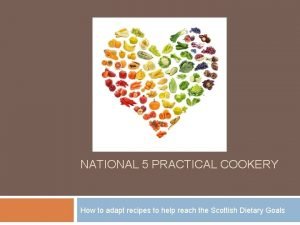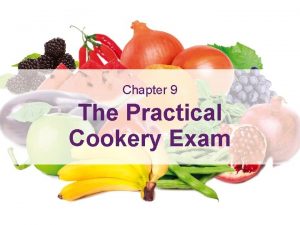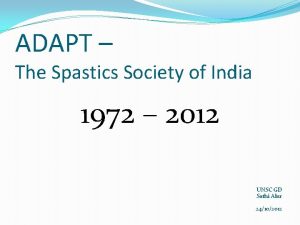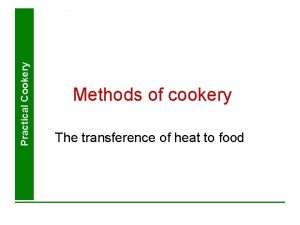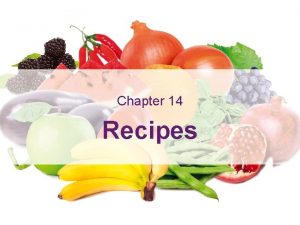NATIONAL 5 PRACTICAL COOKERY How to adapt recipes









- Slides: 9

NATIONAL 5 PRACTICAL COOKERY How to adapt recipes to help reach the Scottish Dietary Goals

The Eatwell Guide This shows the types and proportions of foods people need for a healthy and well- balanced diet. It’s a useful guide when you are adapting recipes.

Modifying Recipes We can adapt or change recipes to help them healthier and reach the Scottish Dietary Goals. We can do this by. . Adding/ changing ingredients Changing the cooking process.

Increasing the amount of fruit or Vegetables in a recipe Add extra vegetables to pizza toppings, curries, casseroles & stews. Use more variety in soups & use vegetables in sauces. Add to sandwiches/ add more to salads Fruits – Add fresh, frozen or dried to breakfast cereal etc. Add dried fruit to baking.

Change/ Increase the amount of Total Complex Carbohydrate Choose High Fibre, low sugar breakfast cereals, add oats to crumbles/ cookies etc Use wholemeal flour Choose wholemeal varieties of bread Bake or boil potatoes with their skin on Add wholemeal pasta or rice to soup to make them more filling Choose wholemeal, rice, pasta or noodles to increase fibre content.

Change the type and quantity of Milk and Dairy Foods Use low fat versions of this food group, semi skimmed milk, low fat yoghurt etc Use natural yoghurt or crème fraiche instead of cream. Use low fat spread instead of butter Use fat reduced cheese such as Edam, cottage cheese. Use strong flavoured cheese in sauces but use less e. g. red Leicester, blue cheese.

Meat, fish, eggs and pulses & alternatives Use lean cuts of meat, extra lean minced beef and trim excess fat from meat. Remove the skin from poultry before cooking to reduce fat. Use methods of cooking that could reduce the fat content e. g. grilling. Add pulses to meat dishes to increase the fibre content, reduce the fat and add extra protein. Eat more fish than red meat as it is low in fat (not in batter!)

Reduce the amount of fat and sugar in recipes Choose a low fat spread instead of butter Use olive, sunflower or rape seed oil instead of butter and margarine. (Fry Light) Change pastry toppings to mash Reduce sugar/ fat content in cakes by changing icings. Use artificial sweeteners or half sugar when cooking. Use reduced sugar versions of jam.

Changing Cooking Methods It’s not always possible to change the cooking method of a recipe but when you can opt for. . Grilling Baking Stewing Steaming Stir frying

